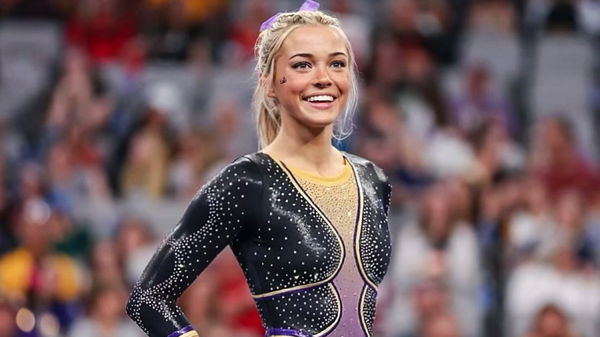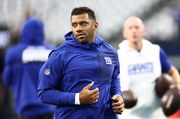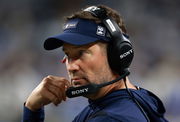

The Name, Image, and Likeness (NIL) deals have changed the equation. Few would have anticipated its impact on the NFL draft when it was legalized by the Supreme Court in 2021. Fast forward to 2024 and we witnessed how NIL led to the thinnest pool of underclassmen in over a decade in this year’s draft. How does this affect the NFL teams looking to do shrewd business in the later half of the draft? Chiefs’ Super Bowl-winning GM Brett Veach highlighted the point and gave an insight into the changing landscape.
Watch What’s Trending Now!
Playing in the NFL and its glory and fame have its appeal. But at the same time, for many players money has been an equally important factor. This is where the NIL deals come in. These days, a player can just choose to be in college and watch the money roll in.
Plus, spending more time in college can help their prospects and can be the difference between going in the second round and the third round. That’s why we’re seeing a decline in top-tier talent in fourth, fifth, sixth, and seventh-round picks these days. There might come a time when the second half of the NFL Draft might feel dry.
ADVERTISEMENT
Raising the concern on the DraftKings podcast on 22 July, Veach pointed out, “During the course of our draft prep you had a large portion of Juniors that maybe had third, fourth round grades, that in years past would decide to come out. Well now, all of a sudden obviously they are staying in school, they’re getting paid. So there is a definitely a drop off I think that that we’ve seen.”
This year saw only 58 underclassmen declare themselves for the draft less than the 69 last year. This number is also the smallest since 2011. To put things into perspective before NIL deals were legalized for college students, 135 underclassmen entered the draft five years ago. But this year, many underclassmen with latter-round draft grades returned to college for another year, their decision to delay a professional year helped by six-figure NIL packages.
ADVERTISEMENT

ADVERTISEMENT
Talking on the podcast, Veach further explained how the draft pans out due to these changes. “Once you get past that third round, the fourth round was not as deep and then even if you get into the 5th, 6th, 7th round, some of the guys you’re looking at are a little bit older in age too. So there’s that little bit drop off in talent and you’re also getting some older prospects too.”
Let’s take the case of the Kansas City Chiefs for a moment. They had 5 draft picks from rounds 4-7 this year. They drafted the TE Jared Wiley and DB Jaden Hicks in round 4. Got away with the OL Hunter Nourzard in round 5, took CB Kamal Hadden in round six and the guard CJ Hanson in round 7. Had NIL not been in the place, things would have been different today. Trying to take away from players’ success is not the move here, but making the NFL great is.
Not everyone is Shedeur Sanders, or Olivia Dunne (top NIL earners) and some people have to make do with what they can get. An example of this is Donald De La Haye aka Deestroying, who popped off from YouTube doing challenges, visiting universities, and such. When the NCAA asked him to demonetize his YouTube channel, he declined, and he was banned from college football. He’s not even in the NFL and still making millions.
ADVERTISEMENT
So how could the franchise tackle this situation going forward? Well, Veach thinks teams will have to go down a different route to strengthen their squads. “I certainly think in the short term teams are going to have to you know reevaluate that and I’m sure you’ll see a little bit more trading up into those top five rounds.”
But it isn’t only the lucrative NIL deals affecting the NFL draft quality. NCAA’s liberal transfer portal has also provided college students with another enticing option. A record 1,127 players placed their names in the transfer portal last year. The number is expected to grow with the NCAA having two transfer-portal windows (Dec. 4-Jan. 4 and April 15-30). Notably, out of the seven quarterbacks invited for the NFL’s audition only one- Michael Pratt of Tulane played for the same college his entire amateur career.
Still, the NIL deals are taking over the sport slowly. Back in February, a month after he announced his retirement legendary Alabama coach, Nick Saban said that college football is changing due to NIL and a “meaningful change” is needed.
ADVERTISEMENT
Talking to ESPN he said, “What we have now is not college football — not college football as we know it. You hear somebody use the word ‘student-athlete.’ That doesn’t exist.” He further added, “We’ve gone to nobody talking about education, nobody talking about creating value for their future, to talking only about how much money can I make while I’m in college.”
Yes, there are voices other than Saban, concerned about the health of college football and subsequently the NFL, but for the time being the NIL is here to stay.
College students are seeing more value in staying put and taking care of their financial needs through NIL deals. We saw that with Florida State player Akeem Dent. He was eligible to be a pro after the 2022 season and would’ve landed on an NFL roster. But he remained with the Seminoles and won the ACC title this year while making money from his NIL deal.
ADVERTISEMENT
Dent said, “Everybody plays football to make life better for them. NIL could help that. It’s not the final straw; professional’s the final straw. But NIL can help with the at-home stresses.” He said the money allowed him to take care of his two young children. Following this year’s draft, Dent was picked by the LA Chargers where he will be looking to make a breakthrough.
It is clear why these deals are seen as enticing by college students and it is likely more of them will turn to such chances to secure themselves financially at an early age. We have a prime example of the Colorado Buffs QB Sheduer Sanders, who has a whopping NIL value.
ADVERTISEMENT
Who are the NIL rulers in 2024?
The NIL 100 list has a new name on top. That’s Shedeur Sanders whose NIL valuation stands at $4.8 million, and he boasts a total of 2.5 million followers on social media platforms including X, Instagram, and TikTok. Shedeur is just 22 and still in college while he owns a Maybach, a Hellcat, and a Corvette Stingray. There’s no denying that his success in Colorado is uncontested.

ADVERTISEMENT
Let’s talk about Livvy Dunne for a minute. She has a whopping $13.1 million followers on X, IG, and TikTok and is evaluated to be worth $3.9 million in the same list. The behemoth number of followers and her accomplishments in athletics has brought forth deals from Vuori Clothing, American Eagle, Plant Fuel, Bartleby, and some others. So, the question is whether the No. 1 college gymnast be tempted to participate in the Olympics someday.
Top Stories
Cowboys Fire Defensive Coordinator Matt Eberflus: Contract, Salary, NFL Earnings & More

Russell Wilson Announces Retirement Stance as Giants QB Shares Hidden Injury News

Dolphins Reportedly Indecisive About Mike McDaniel as GM Search Kicks Off

Joe Flacco Makes Retirement Decision Clear as Bengals QB’s Final Gesture for Ja’Marr Chase Draws Attention

Brian Schottenheimer Calls Out Controversial Jaxson Dart Incident as Cowboys Star Awaits NFL Punishment

Dunne is the only female athlete who’s in the top 10 of On3’s NIL valuations. She’s followed someone who comes from a long line of football lineage, Arch Manning, who’s a sophomore QB for the Longhorns. He’s evaluated to be at $3.1 million.
The question at the end of this remains. Do you still think athletes would declare for the NFL if they knew they wouldn’t be 1st- 3rd round picks given they are making too much money outside of professional sports? Let us know what you think.
ADVERTISEMENT
ADVERTISEMENT
ADVERTISEMENT

